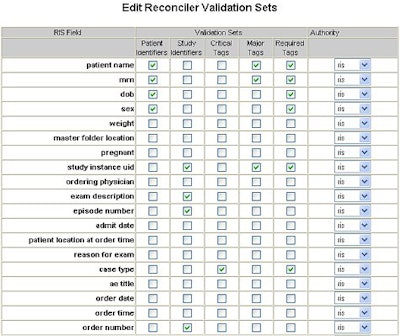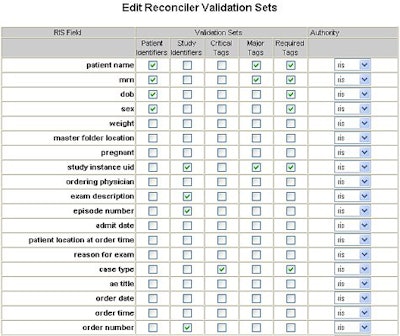
SAN DIEGO - The linkage of administrative, financial, and demographic patient data with associated imaging studies is being hotly pursued by most RIS vendors. Information technology vendor Misys Healthcare Systems of Tucson, AZ, unveiled its two-pronged solution to RIS/PACS integration at this week's Healthcare Information and Management Systems Society (HIMSS) conference.
The first part of the developer’s strategy is its PACS Integration Module (PIM). The PIM is an application that resides between a PACS and Misys Radiology, the firm’s RIS. The product communicates directly with the PACS via DICOM 3.0, and provides a modular toolkit of RIS/PACS integration applications.
"We built the PIM to be modular from the ground up so that a client can structure the product to precisely meet the needs of their site," said Kenneth Bonner, director of the company’s radiology product line.
The PIM performs a variety of functions, including:
- DICOM modality worklist management directly from the RIS to the PACS.
- DICOM storage and DICOM query/retrieve from the RIS to the image archive.
- DICOM modality performed procedure step.
- DICOM general purpose worklist to PACS workstations.
- Autorouting of exams to designated locations.
- Prefetching of images from the archive as well as relevant previous exam capabilities.
- Automatic reconciliation of patient and exam information from the PACS and the RIS.
- Automatic notification of exam status and results
All of the tools can be configured from an administrative-level setup application that permits customization for an institution's specific needs.
 |
| With the PACS Integration Module, users can specify rules for automatic image reconciliation and determine whether the RIS or imaging modality has the most accurate data. Image courtesy of Misys Healthcare Systems. |
Bonner said the company chose to focus its RIS/PACS integration efforts on the client, rather than attempt to mold the product to fit each PACS vendor’s offering.
"By engineering the PIM to work with all DICOM Type 1, 2, and 3 tags -- and enabling administrative association of those tags with their corresponding elements in the RIS on a case-by case basis -- the product is able to integrate with any PACS made by any vendor," Bonner said.
In addition, by creating a product for site-specific installation requirements, Bonner said the firm was able to avoid being put in the position of relying on other vendors for software hotfix and upgrade notifications.
A single PIM can handle interfaces from heterogeneous PACS at multiple sites from within a facility’s network, reconcile the data, and bring it into the RIS. A benefit of this architecture is that it enables an institution to avoid the traditional price structure of paying for licenses for multiple interface engines.
"Because the image archiving is taking place from the RIS after the images have been reconciled from the PACS, we’re able to store it as HL7-compliant data, also eliminating the need for HL7 interfaces to a HIS," Bonner said.
Bringing a PIM system online takes about a week, according to Bonner. The process includes configuring the DICOM-to-RIS variables from an institution’s modalities and PACS, and training system administrative-level employees to use PIM's capabilities.
He said the PIM will be available worldwide for approximately $150,000, depending on configuration with the rollout of Misys Radiology 4.2, scheduled for July 2003.
eRad partnership
For customers who want a single-access, single-screen PACS/RIS, the firm has partnered with image management provider eRad/Image Medical of Allentown, PA. The joint-development agreement will permit the firm to offer its RIS/PACS to the user in one application screen, eliminating the need to have multiple applications running simultaneously on the desktop.
The developers began sharing application programming interfaces (APIs) and performing joint code reviews as part of the due diligence process, giving the companies a leg up on integration efforts, said Larry McCants, eRad/Image Medical vice president of business development.
The PracticeBuilder PACS is comprised of a platform-independent Web-based viewing application. The application was built on HTTP 1.1 standards for maximum portability, and its Web server was developed on Red Hat Linux for the same reason, according to Bobby Roe, eRad/Image Medical’s director of technology.
The diagnostic viewing portion of the PACS sits on a 32-bit Microsoft Windows platform, allowing a facility to use any of Microsoft’s 32-bit operating systems from Windows 95 to Windows XP. The product has built-in dictation capabilities that can interface with Agfa HealthCare’s Talk Technology-developed TalkStationRadiology voice recognition system that are part of the Misys RIS.
Both the PIM for existing PACS and RIS integration and the PACS/RIS product bundle permit automatic routing of images and reports, not only to physicians and departments within an enterprise, but to referring physicians outside the institution’s primary network as well, McCants said.
The products use e-commerce-level 128-bit encryption, bilevel password authentication, and rules-based user access down to the patient-record level, meeting all published guidelines on Health Insurance Portability and Accountability Act (HIPAA) security rules, according to Roe. Audit capabilities in Misys Radiology permit transaction tracking of all input and edit functions performed on the RIS.
The initial release of the integrated eRad/Image Medical Misys Radiology PACS/RIS bundle is expected by the third quarter of this year, with installation at early-adopter sites slated for early in the second quarter, according to McCants and Bonner.
By Jonathan S. BatchelorAuntMinnie.com staff writer
February 12, 2003
Related Reading
Misys, eRad/Image Medical form RIS/PACS alliance, February 11, 2003
Misys, MedCath ink deal, January 7, 2003
Misys signs New Liberty Hospital, December 11, 2002
PACS firms integrate, broaden product lines, Part II, November 18, 2002
Misys enhances flagship RIS, October 31, 2002
Copyright © 2003 AuntMinnie.com



















